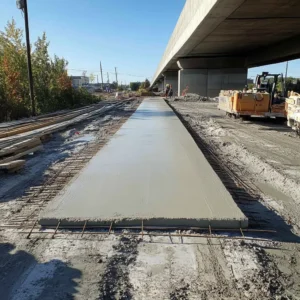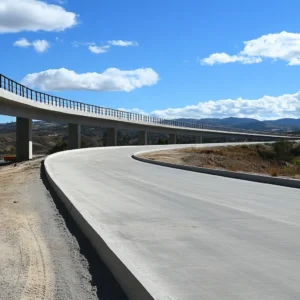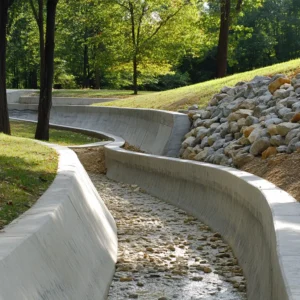Infrastructure and Civil Engineering
The Role of Fibers in Infrastructure and Civil Engineering
Introdução
As urbanization accelerates and the demand for durable, sustainable infrastructure grows, innovative materials are shaping the future of civil engineering. Among these materials, fibers—particularly polypropylene fibers, polyester fibers, steel fibers, and cellulose fibers—play a pivotal role. Fiberego is at the forefront, delivering solutions tailored to infrastructure challenges. This article explores how fibers are revolutionizing infrastructure applications like roads, bridges, tunnels, and beyond.
Types of Fibers in Infrastructure Projects
Polypropylene Fibers
Polypropylene fibers are synthetic materials known for their high tensile strength and resistance to chemical degradation. They enhance crack resistance and durability in concrete structures, making them ideal for:
- Roads and Highways: Reducing shrinkage cracks and increasing lifespan.
- Tunnels: Mitigating fire risks with improved spalling resistance.
- Sewerage Systems: Enhancing resistance to chemical erosion caused by wastewater.
Polyester Fibers
Polyester fibers are valued for their flexibility, durability, and UV resistance. Key applications include:
- Bridges: Providing additional tensile strength in pre-stressed concrete.
- Coastal Protection Structures: Reinforcing seawalls against wave impact.
- Urban Infrastructure: Supporting lightweight concrete designs in parks and sidewalks.
Steel Fibers
Steel fibers are metallic reinforcements added to concrete for exceptional load-bearing capacity and toughness. Common uses are:
- Dams and Reservoirs: Reinforcing spillways to withstand hydraulic pressure.
- Power Plants: Supporting heavy-load bearing floors and structural elements.
- Ports and Harbors: Strengthening concrete slabs for durability under heavy machinery.
Cellulose Fibers
Cellulose fibers, derived from natural sources, are eco-friendly reinforcements with excellent water-retention properties. Applications include:
- Land Reclamation Projects: Enhancing soil stabilization in reclaimed areas.
- Water Supply Systems: Improving mortar workability and crack resistance in pipelines.
- Telecommunication Towers: Increasing weather resilience in cement-based structures.
Key Applications of Fibers in Infrastructure and Civil Engineering
Roads and Highways
Fibers in road construction enhance durability, reduce cracking, and improve resistance to traffic-induced stress. Polypropylene fibers, for example, offer superior shrinkage crack resistance in asphalt overlays and concrete pavements.
Bridges
Bridges benefit significantly from fiber reinforcement. Steel fibers add load-bearing capacity, while polyester fibers enhance flexibility, ensuring long-term performance under dynamic loads and environmental stress.


Tunnels
Tunnel linings require high tensile strength and fire resistance. Fibers like polypropylene prevent explosive spalling during fires, ensuring structural integrity and safety.


Railways
Fiber-reinforced concrete sleepers and tracks deliver improved shock absorption and extended service life. Steel and polyester fibers are commonly used to handle the dynamic loads of high-speed railways.
Dams and Reservoirs
Hydraulic structures demand durability and crack resistance. Fibers such as steel enhance tensile strength, while cellulose fibers improve water retention, reducing shrinkage cracks in concrete linings.
Advantages of Fiber Reinforcement in Infrastructure
Enhanced Durability
Fibers improve the structural integrity of concrete, reducing the risk of cracking and extending the lifespan of infrastructure.
Cost Efficiency
By minimizing the need for repair and maintenance, fiber-reinforced materials reduce long-term costs.
Environmental Sustainability
Cellulose fibers provide a biodegradable option, while synthetic fibers like polypropylene reduce reliance on heavy steel reinforcements, lowering carbon footprints.
Improved Safety
Fibers, particularly polypropylene and steel, enhance fire resistance in tunnels and power plants, safeguarding lives and assets.


Why Choose Fiberego for Fiber Solutions?
Fiberego specializes in manufacturing and supplying high-quality fibers for the construction industry. Here’s why Fiberego is the preferred partner:
- Innovative Products: A diverse range of fibers tailored to specific infrastructure needs.
- Sustainability Focus: Commitment to eco-friendly practices and materials.
- Expert Support: Technical assistance to optimize fiber usage in projects.
- Global Reach: Proven track record in major civil engineering projects worldwide.
Future Trends in Fiber-Reinforced Infrastructure
With advancements in material science, the role of fibers in civil engineering is expanding. Innovations include:
- Smart Fibers: Sensors embedded within fibers for real-time structural health monitoring.
- Hybrid Fiber Composites: Combining multiple fiber types for enhanced performance.
- Sustainable Solutions: Development of fully biodegradable fibers for eco-conscious construction.
Conclusão
Fibers are redefining the possibilities in infrastructure and civil engineering. From enhancing durability to reducing costs and environmental impact, fibers are indispensable in modern construction. Fiberego’s expertise in polypropylene, polyester, steel, and cellulose fibers ensures reliable and innovative solutions for projects of any scale.
Elevate your infrastructure projects with Fiberego—where innovation meets durability.


